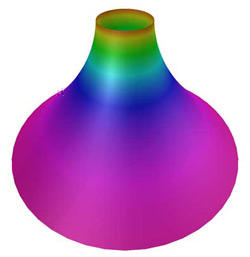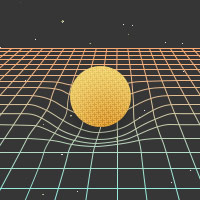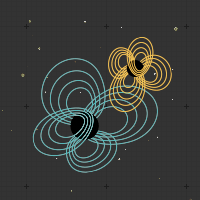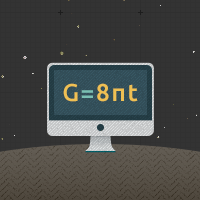Black Holes
The Very End of Space and Time
Now, here, you see, it takes all the running you can do, to keep in the same place. If you want to get somewhere else, you must run twice as fast as that.
The Red Queen in Lewis Carroll's
Through the Looking Glass
Just as white dwarfs can get too massive for their electrons to support them, so too can neutron stars become too heavy for their neutrons. When gravity wins in a neutron star, however, Nature has no more tricks left. All of the matter is sucked down into one single point. With all this density, space and time warp so severely that the very fabric of spacetime is torn. The gravity is so extreme that not even light can escape, and time itself comes to an end. A black hole has formed.
We call a black hole a "star", even though it is completely unlike what we normally think of when we think of a star. To see how, take a disc reaching through the middle of this star, just as we did before. The "hill" feature we saw in the neutron star has turned into something much worse here. We can't show all of it in this picture; it won't fit into our space and time. If we try to draw a circle around this hill, we find that no rope from the outside can possibly reach down to its center without snapping. What's worse, the relative rate of time's flow slows to nothing at the edge.
 This hole in the middle of the hill has a name. It represents a sphere in three-dimensional space called the event horizon. This unique surface is the place where everything inside is cut off from the rest of the Universe. It turns out that anything that moves to the inside of this sphere can never get back out. Even light, travelling as fast as anything possibly can, cannot get out. This is why it's called a black hole.
This hole in the middle of the hill has a name. It represents a sphere in three-dimensional space called the event horizon. This unique surface is the place where everything inside is cut off from the rest of the Universe. It turns out that anything that moves to the inside of this sphere can never get back out. Even light, travelling as fast as anything possibly can, cannot get out. This is why it's called a black hole.
The size of this surface grows with the mass of the black hole. If our Sun turned into a black hole, the event horizon could be surrounded by a circle just 9 kilometers — about 6 miles — around. (The Sun as it is today is over four million kilometers — 3 million miles — around.) A black hole which is twice as heavy would be twice as big around.
Now, your age-defying twin might notice that time near the event horizon doesn't just appear to slow to a crawl, but appears to stop all together! If your twin left you and got too close to the event horizon, your twin would stop aging entirely, from your point of view. Your twin's life would simply seem to be on pause for eternity.
Unfortunately, this fate is not what your twin would experience. Your twin would actually pass through the event horizon, and find the time and space on the other side. But this time and space is pretty special. Your twin could not possibly avoid crashing into the point in the center containing all the matter of the star, in a very short amount of time. This is an example of different observers taking different slices of spacetime, and seeing vastly different things: you see your twin slow down and stop at the event horizon; your twin sees the horizon come and go.
That point in the center which will soon hold the remains of your hapless twin is called a singularity. All the mass of the black hole is crushed into an infinitesimally small region. This warps the spacetime so severely that the warping is actually infinite. You might say that the very fabric of spacetime has been torn, and a tiny point taken out of it. The physics close to singularities is still a mystery. We are almost certain, however, that they exist, and are found hidden at the centers of black holes.
We might also wonder whether or not black holes can have bumps, just like the neutron star we saw above. It turns out that this is possible. The event horizon will change shape whenever something falls in, leaving it bumpy. However, these bumps will spread out and ripple around the event horizon, just as a stone dropped in a calm pond will disturb the water momentarily. As the bumps ripple around, they will make all spacetime around them ripple just the same. The black hole will give off gravitational waves. These waves carry off energy, and make the event horizon stop rippling. A black hole with no spin will settle down into a perfect sphere. A spinning black hole will settle down to a slightly flattened sphere.
Listen to the sounds of a black hole, as it sheds its bumps after a tumultuous encounter. As the hole gives of its ripples in the form of gravitational waves, it sounds similar to a taut drumhead. The more massive the hole, the larger the drum; the more quickly spinning the hole, the more taut the drumhead.
A black hole ten times more massive than our own Sun
A black hole twenty times more massive than our own Sun
A black hole forty times more massive than our own Sun
A quickly-spinning black hole ten times more massive than our own Sun
A quickly-spinning black hole twenty times more massive than our own Sun
A quickly-spinning black hole forty times more massive than our own Sun
In fact, for a calm black hole — after the rippling stops—there are just three things that completely determine how the black hole's gravity looks to anyone on the outside: its mass, the amount of electric charge it contains, and how quickly it spins. Any two calm black holes with the same mass, charge, and spin will look exactly the same in every other respect. A lone black hole is not expected to have much of a charge, so astrophysicists usually just talk about the mass and spin of a black hole.
The Evidence for Black Holes
 One of the problems with black holes is that they are — naturally — very hard to see. Fortunately, black holes affect things around them through their intense, unmatchable gravity. These nearby things frequently give off light, allowing us to watch as the black hole pulls them around. For example, we might see a star floating in what appears to be empty space. But if this star is moving in a circle, we would know that there must be some massive object warping the spacetime near the star. By measuring how quickly the star is orbiting, astronomers can deduce how heavy the central object is. If there is enough mass packed into a small enough volume, with no light coming out, we would likely have a black hole. Stars orbiting like this around unseen dark objects have actually been found. By watching stars like the ones in the pictures, astronomers can measure how quickly they are orbiting. These particular clusters of stars have been measured, and are suspected of harboring black holes.
One of the problems with black holes is that they are — naturally — very hard to see. Fortunately, black holes affect things around them through their intense, unmatchable gravity. These nearby things frequently give off light, allowing us to watch as the black hole pulls them around. For example, we might see a star floating in what appears to be empty space. But if this star is moving in a circle, we would know that there must be some massive object warping the spacetime near the star. By measuring how quickly the star is orbiting, astronomers can deduce how heavy the central object is. If there is enough mass packed into a small enough volume, with no light coming out, we would likely have a black hole. Stars orbiting like this around unseen dark objects have actually been found. By watching stars like the ones in the pictures, astronomers can measure how quickly they are orbiting. These particular clusters of stars have been measured, and are suspected of harboring black holes.
The most likely place we would expect to find a large concentration of mass is right among lots of other mass — at the center of a galaxy, for instance. If a black hole took up residence in the middle of a galaxy, it could eat up many stars and grow into a huge black hole. Indeed, astronomers have found stars in the center of our own Milky Way galaxy orbiting with astonishing speeds. Some stars orbit the center every 15 years, at speeds of over 3,000 miles per hour.  That means that whatever is warping spacetime in the center of our galaxy is several million times as massive as our Sun. All that mass, however, is packed into a region just a few times bigger than our Sun is now. With so much mass packed into such a small region, physicists can't imagine anything but a black hole.
That means that whatever is warping spacetime in the center of our galaxy is several million times as massive as our Sun. All that mass, however, is packed into a region just a few times bigger than our Sun is now. With so much mass packed into such a small region, physicists can't imagine anything but a black hole.
In fact, it seems likely that most galaxies have a supermassive black hole at their centers. Some of these black holes are swallowing matter so quickly that the matter falling in bumps into other matter. All this bumping, at the extreme speeds around a black hole, makes the matter heat up tremendously. All that heating makes the matter glow, as in the picture below on the left, which shows a galaxy with a supermassive central black hole at its center.
Sometimes this hot matter gets caught up in a magnetic field. Because of the odd nature of the magnetic force, such quickly moving matter may actually curve away from the black hole, and be shot out away from the center of the galaxy. A supermassive Black Hole in the middle of so much matter would actually be extraordinarily bright. Astronomers have identified many sources they call active galactic nuclei (or AGNs) which shine more brightly than all the stars found in the galaxies around them. These AGNs are believed to be powered by black holes.
A quasar is a similar object seen in the far reaches of space. To the casual observer, quasars appear just like regular nearby stars. However, careful measurements by astronomers show that they are extraordinarily far away. This means that they must be extraordinarily bright, also. In fact, the light they give off is sometimes brighter than dozens of normal galaxies. For something to be so energetic, it must have plenty of matter to fuel it—that is, it must be fantastically massive. On the other hand, the light coming from a quasar changes greatly every few months, days, or hours. If a huge object were to change in brightness, we would expect that change to happen very slowly. In particular, scientists believe that an object can only change in brightness as quickly as it takes light to move from one side of the object to the other. This means that a typical quasar might only be comparable in size to our solar system. Again, all that matter packed into such a small region can only be explained by a black hole—as far as we know. All of this evidence is not rock-solid. Observations with gravitational waves have the potential to give us far more solid facts to prove the existence of black holes.
Hawking Radiation
The black holes we've seen above were defined to be regions of spacetime from which nothing can escape. According to general relativity, such regions can exist, and in fact must be the final state of any star weighing in at more than a few times as much as our Sun. Unfortunately, that's not the whole story.
Current theories of physics are only approximately correct. Newton's classical theory of motion and gravity was just like this. It worked very well in most cases, but there were exceptions. With the General Theory of Relativity, Einstein filled many of the gaps. He could not fill all of them, however.
There is another modern theory of physics called quantum mechanics. This theory deals with very small, and very energetic particles. Quantum mechanics is vital, for example, when trying to describe electrons moving around an atom or inside a computer chip. Trying to describe these things with general relativity leads to complete failure. On the other hand, trying to describe gravity with quantum mechanics also leads to complete failure. Neither theory is always wrong, but neither theory is always right.
Quantum field theory in curved spacetime is an attempt to bring quantum mechanics into the curved spacetime of general relativity. This theory allows us, for instance, to understand the behavior of tiny particles like electrons and photons in areas of extreme curvature — around a black hole, for example.
One of the many surprising predictions of quantum field theory is that the vacuum of space is actually a boiling soup of virtual particles. These are pairs of particles that flit into and out of existence, very briefly. Virtual particles will borrow energy from the empty space around them, leaving that space with negative energy. Ordinarily, the empty space will then pull the virtual particles back to regain its energy. In an area of extreme gravity, however, the particles can gain enough gravitational energy that the are able to return the borrowed energy to the empty space, and survive as real particles. One virtual particle falls into the hole, while the other escapes. A black hole is constantly giving off this faint glow of escaping particles as Hawking radiation. It gives up its energy and mass to the particles steaming from it. Over very long times, this leakage drains mass from the black hole so that it shrinks down. If nothing were to fall in to offset this loss, the hole could evaporate into nothingness.
In 1974, Stephen Hawking used the theory of quantum fields in curved spacetime to prove that this phenomenon takes place. It was a great surprise to everyone — especially because it seemed to contradict one of Hawking's own previous great successes in Relativity theory, and to go against intuition about what a black hole is. Over time, more and more experts came to agree with Professor Hawking. Never one to shy from controversy, Hawking has come to support another new idea about black holes. His new position may yet rescue something of our notion about black holes as places where all is lost forever.
We can imagine sending something into a black hole, and trying to see if the evaporation coming out was affected by whatever we dumped in. Hawking's belief (currently) is that whatever has gone into the black hole will have absolutely no effect on what comes back out. What is surprising about this position is that it runs contrary to what Hawking believed for many years. His reversal is simply a demonstration of the difficulty that even the most respected experts have in understanding how black holes work. There is still much to be explored, tested, and understood about black holes, and spacetime in general, as well as quantum mechanics. How these two theories — relativity and quantum mechanics — fit together is perhaps the greatest and most promising mystery in all of physics.








